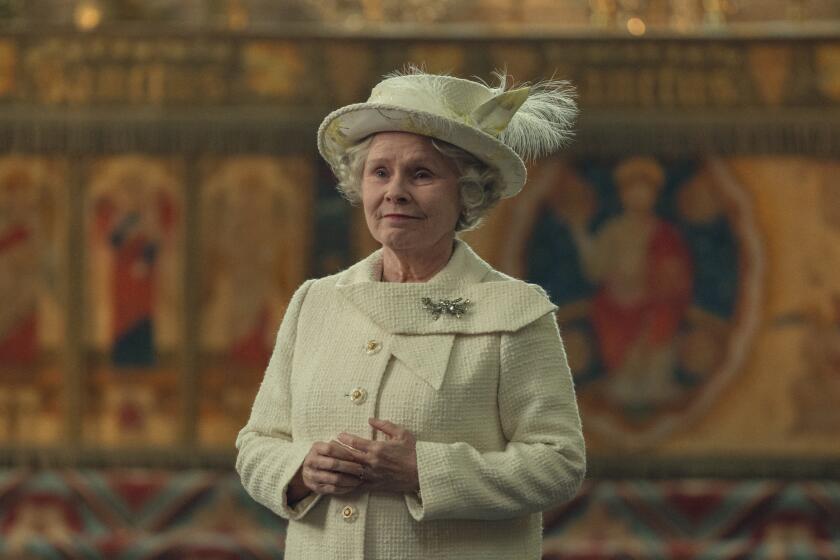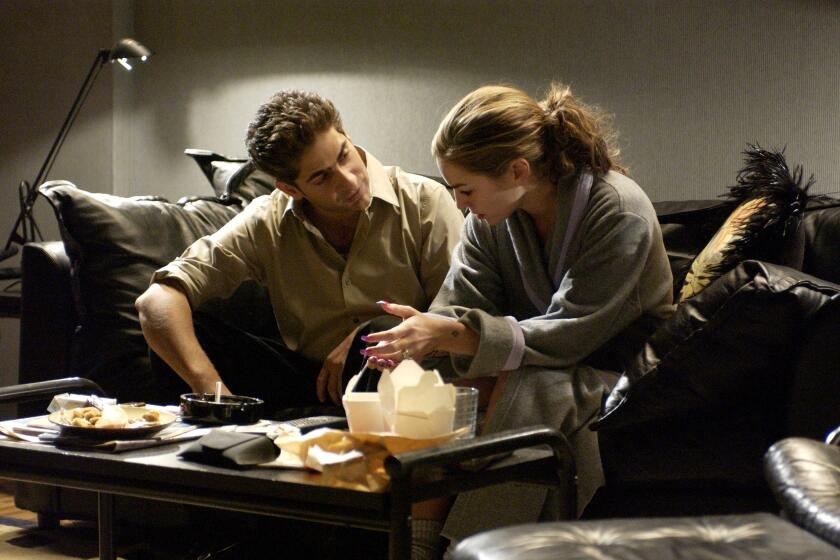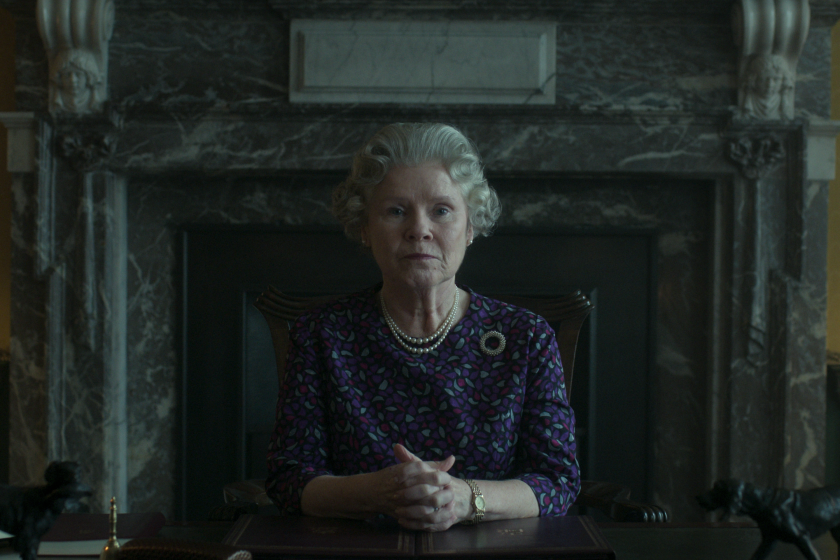How ‘The Crown’ re-created history while still respecting the women who suffered
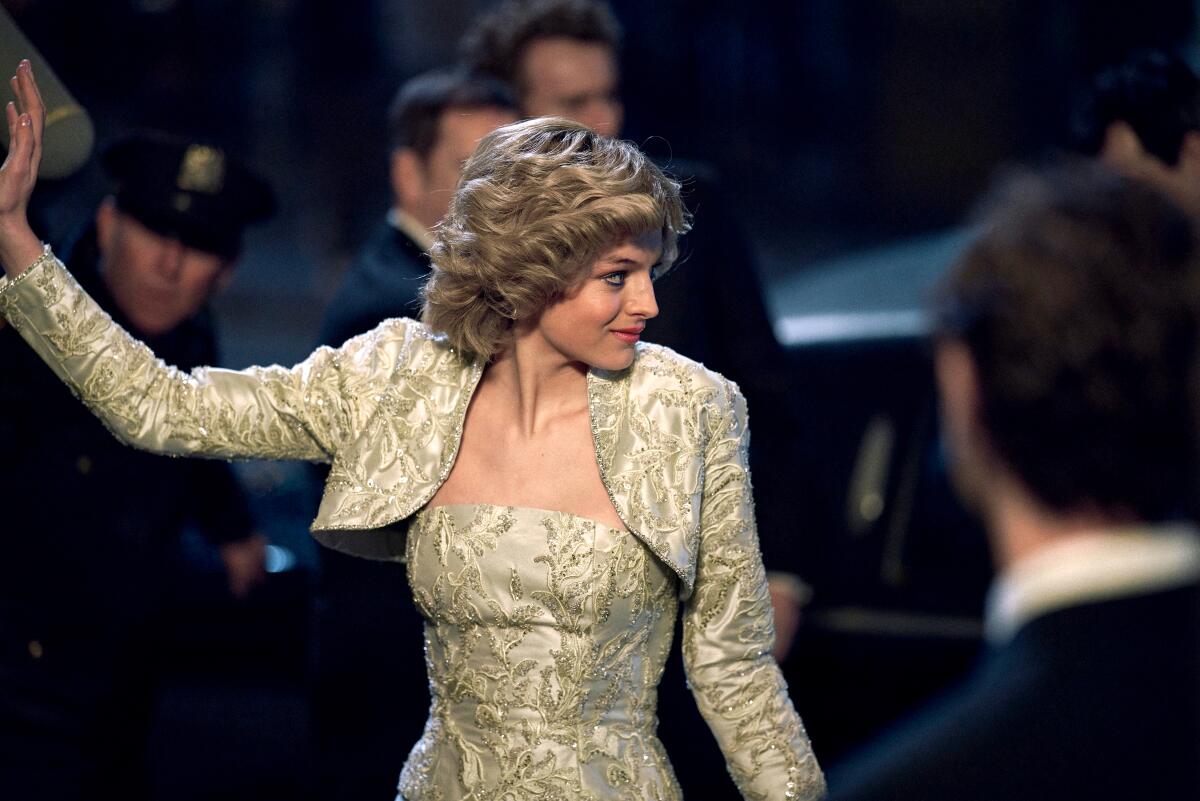
In “Inside the Episode,” writers and directors reflect on the making of their Emmy-winning episodes.
“War,” the Season 4 finale of Netflix’s monarchy drama “The Crown,” is an icy one.
And that’s not just because it’s set just before and during Christmas.
This portion of the story of Queen Elizabeth II (Olivia Colman) and her ilk is about the marriage that is destroying the lives of her oldest son and heir apparent, Charles (Josh O’Connor), and his long-suffering wife, Diana (Emma Corrin). It’s also about Parliament finally bending its Iron Lady, Prime Minister Margaret Thatcher (Gillian Anderson).
The finale of “The Crown,” titled “Sleep, Dearie, Sleep,” features Prince Charles and Camilla Parker Bowles’ wedding, but creator Peter Morgan says it’s a pretext for the queen wrestling with whether or not to abdicate the throne.
In a more relatable sense, as Jessica Hobbs’ Emmy-winning direction shows, it’s also about that icky, awkward, self-conscious feeling people get when they’re forced to be in a room where they know they’re not wanted. In different ways, Hobbs focuses the camera on Anderson’s and Corrin’s ostracized women as they attempt to keep a stiff upper lip even though every hair on their body is at attention and they count the seconds before they can retreat to the privacy of their rooms to cry, scream and crumble on the bed.
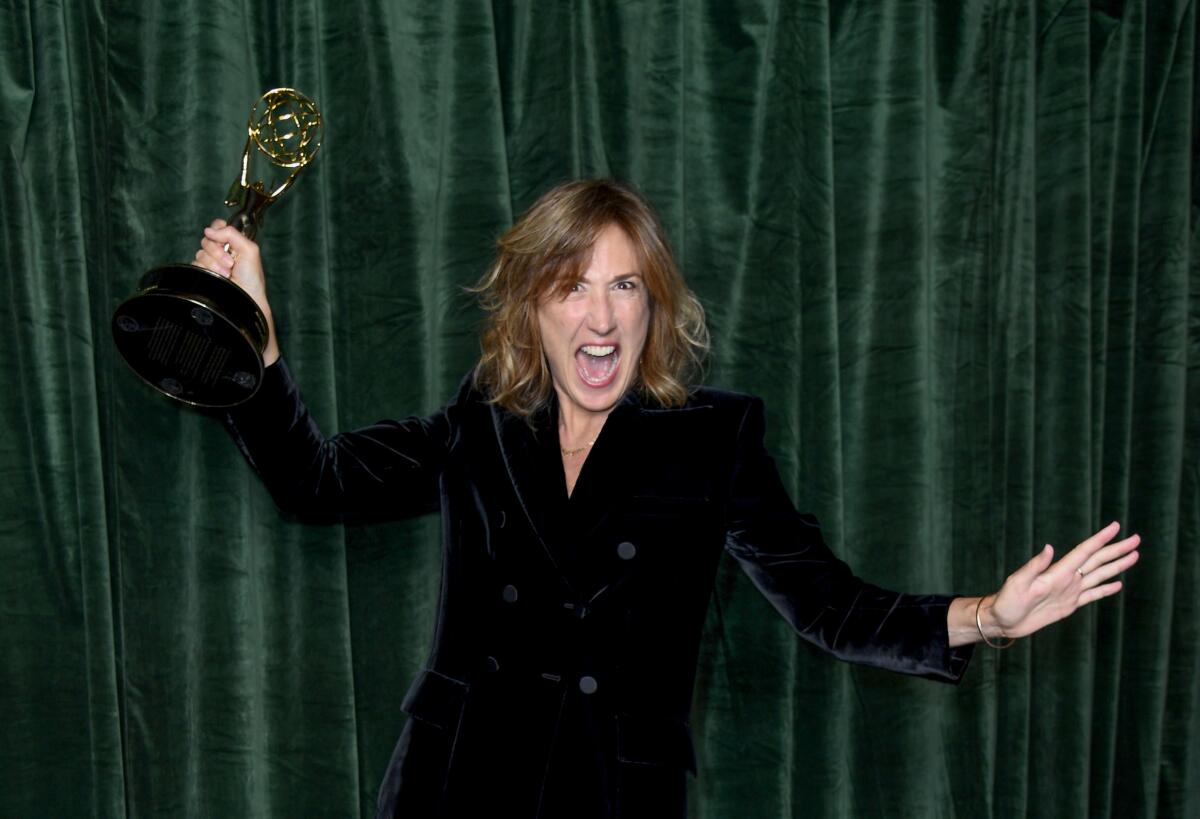
Hobbs, who has directed several episodes of the series created by Peter Morgan, tells The Times that there were a few reasons why she asked for this episode. One is she likes the completed feeling of a season finale, when all the stories come together. Another is that this would be the final episode with this cast, as the show rotates in younger actors for older ones every couple of seasons to tell the stories of the actual people it’s depicting. And, she says, this one came with a lot of girl power.
“That particular episode, I felt, was very female-centric,” she says. “And I wanted to land those women’s stories in a way that perhaps reflected their isolation as strongly as I felt it. We knew their public stories. It’s the behind-the-scenes stories that I was interested in reflecting more.”
Here, Hobbs thinks about the color palette for the episode, the feeling of betrayal these women felt and how to re-create history while still respecting those who suffered (such as Diana’s well-documented eating disorder).
There seems to be a lot of blue in this episode. There’s an icy blue coming through the windows as we set up the morning. At the end, when Diana comes to Christmas with the royals, she stands out in a blue tartan suit while everyone else is in more muted colors …
For the opening scenes, the director of photography, Ben Wilson, and I wanted to set up an early-morning blue feel, which was actually going to occupy the way you would watch the episode. This was the ending of a lot of things. The very first man that you meet [Paul Jesson’s Sir Geoffrey Howe] is about to start that ball rolling. He’s going to start Thatcher’s downfall, which will tip the queen into a different place. And it starts to expose Charles and Diana’s relationship.
We were coming into a whole winter period. And so we wanted winter, Christmas, low light, single sources. It was something that affected the kind of palette of the whole episode. It wasn’t summery and bright.
Also, that family has a uniform. For a while, Diana would go along with that. And she very deliberately in those later years started to dress in a way that she was more comfortable [with] for herself. And we really wanted to reflect that. If she’d maybe taken two steps forward and said, “Hello,” someone would have said hello back to her. But there was just like this gulf, this chasm, that existed in there and [costume designer Amy Roberts and I] felt that the costumes really reflected that.
Jeffrey Blitz talks about directing the Emmy-winning ‘Office’ episode ‘Stress Relief,’ the art of cat stunts and comedian Cloris Leachman’s commitment to her craft.
The episode also opens with the morning routine of a peripheral character. Geoffrey Howe isn’t a name immediately known to outsiders, but it’s his speech in Parliament that brings down Thatcher. You also shot her reacting to his remarks from a lower angle and close up, as if to see if we’d catch her cracking.
It’s really lovely starting on a character that you don’t know because … you have the audience’s full concentration because they’re trying to figure out what’s going on.
And I did two things in [the Parliament] scene. I sat underneath her because I wanted to feel her vulnerability. And I shot her from his point of view. He wasn’t looking at her, and she never fully turned. Gillian and I talked about this quite a bit. I think you’re very conscious when a speech is being made about you that isn’t going to go well, and the physicality of her keeping her back to him was really important to me to portray.
You also track her slow walk and car ride home before she finally makes it upstairs to her room. But the camera only peeks in at her crying there. It’s like you’re still giving her some dignity and privacy.
It’s actually [several filming] locations, so hats off to Gillian. She’s in the car and walking through her aides on another day. And then going up the stairs on that same day, and then into the hallway and into the bedroom on a fourth day. So for her to maintain that composure of where she was emotionally, I thought was great. But I wanted it to feel like it was one procession, that she was just going to the smallest, quieter space she could find and that’s the only place she could actually let her emotion show. Rather than voyeuristic, we were being respectful of the privacy of the moment.
This also speaks so much to people in power, particularly women, who aren’t allowed to show vulnerability.
Gillian and I talked about this. We felt there were two places in the episode where she could show vulnerability. That was more of a horror landing on her. In the meeting with the queen, [later in the episode], where she comes in to ask her to dissolve Parliament, we wanted to make sure that we created a balance between those two, that one didn’t rob from the other.
Terence Winter reflects on writing his Emmy-winning “Sopranos” episode in which Adriana is killed.
This scene with the queen is one of many where it’s people sitting and talking. Obviously, what they’re saying is important. But as a director, how do you film them in such a way that keeps the audience engaged?
A lot of it’s to do with making sure that the camera reflects the status and the space around them, and that we give time to let the tension build up. And it was also choosing when to allow people to look directly into each other’s eyes and when to observe them more from a slightly more profile angle. We give ourselves a lot of time to shoot the different shots that we know will build up to that dynamic.
I love that rigidity of Thatcher. Interestingly, in that second scene where she cried, she didn’t expect to. I didn’t expect her to. Olivia certainly didn’t. And Olivia is so empathetic. I’m like, “Don’t you be nice to her. When we’re finished filming, you can go outside and give her a hug.”
It was the way the words hit her at that point, that they just landed for her so strongly and it felt like it was finally over. Whereas earlier, walking up the stairs is an enraged moment and a sense of the brutality for all of those men closing down on her. This was her going to another woman and just [more or less saying], “It’s done. Game over.”
In one of these conversations, Queen Elizabeth awards Thatcher with the Order of Merit. I don’t know if what was said between these two women is accurate. But it’s interesting that you held the camera on the medal’s box, which Thatcher had left on the table. Is that a subtle, “You’re not done with me yet” jest?
No one knows what happens in private audiences with the queen. So those are always made up. … So it’s always a great place to hang important dramatic scenes. … We worked very hard to find the uncomfortability for the queen in her relationship with Thatcher, but that she was wanting to give some recognition to another woman who had been in a very senior position for a number of years and in a difficult way.
We were still arguing about [how to end] it in postproduction. She’d said goodbye in one of the takes, and I took it out. I really love how uncomfortable it is, the silence at the end of it.
We had a lot of conversations about it [leaving the box] in the room. We decided that there were people who can take care of that and will get the box to her. I also liked it from a visual sense. Particularly with female characters, like if someone goes out and they’ve got a really elaborate hairdo, I’m like, “Who did that for them?” In story terms, I’m always looking at what the logic is of how their appearances are.
Distracted by tabloid drama and ageist in their construction, the final seasons of ‘The Crown’ turned Netflix’s most acclaimed series into a rehash of scandal and tragedy.
You do show Diana’s bulimia. But, like the Thatcher scene, it’s handled in a respectful way. Were there conversations as to how much of her eating disorder to show, both to honor her and any audience member experiencing this?
We had many conversations about it and a lot of research and consultation. It’s something we knew about her and it’s also something that’s not uncommon. I felt — and I know Emma felt this very strongly too, and so did the cinematographer, and we talked to Peter about it as well — that I wanted to accentuate the loneliness of it, the isolation of it, rather than the energy of the act itself. The times we show it, you hear it and you’re aware of it. But we actually shot it in a mirror as part of the bathroom cabinet. And then she sat down next to the toilet slowly as we went in toward her. The visceral sound of it, I felt, was enough for people to both understand but also to experience the desperate sadness of it in terms of what’s going on with her emotionally.
And then the second time was just constructing in a way that we felt we could tell that story visually that she was done. She’d had an argument with Charles that just tipped her almost into a new way of being. And that’s also why [the episode is] called “War.” When you get to the end of the episode, she has now been tipped into, “I’m gonna fight for my corner now.”
The episode also has to re-create another well-documented event: Diana’s trip to Harlem, New York, where she became one of the first public figures to embrace AIDS patients. How do you do that without it being a parody?
I think we tried to find a line where hopefully you had the emotional experience. One of the doctors we spoke to who was there at the time said that she was smart enough to know that, by using her media presence, that would draw attention to something that needed drawing attention to. I also wanted the kid [she hugs] to have some kind of agency and not just to be a figure in a bed.
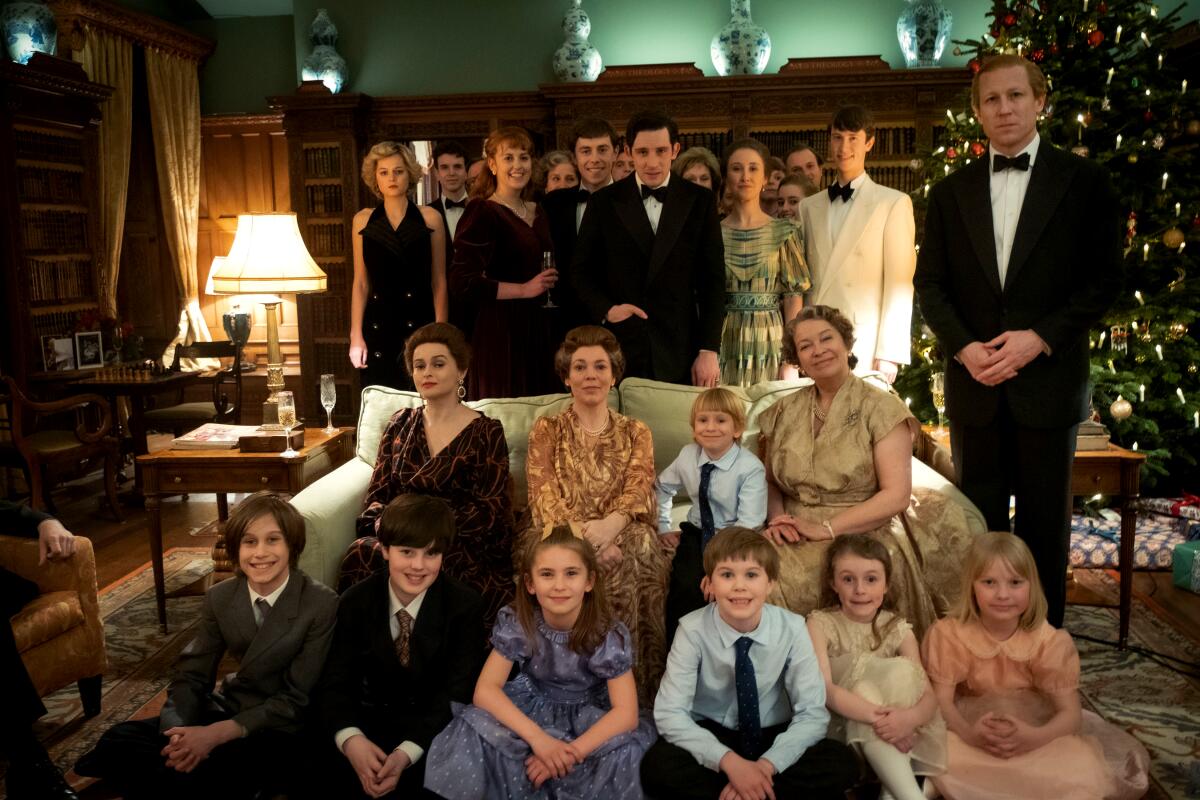
The episode ends with Diana submitting to being a part of the family’s Christmas photo. However, she’s wearing a much more fashionable black velvet evening gown and standing apart from everyone.
She is dressing like it’s her own funeral. What was so beautiful was [costume designer Roberts and I] talked about the exposure of her back and how exposed she felt. That dress allowed me to shoot her from behind, just to have that visceral understanding of how exposed this woman felt in this room full of people who were supposedly family.
The queen’s love of corgis is well documented both in “The Crown” and in actual photographs. Is there an art to casting corgis?
There’s a bunch of corgis. Prince and Lily are the lead two, but very problematic. Some of the others were good. I mean, you don’t see the bits in between where some of the dogs go slightly ballistic. … I loved the kind of knockabout nature of working with them and the fact that they could slightly upend the scene.
More to Read
From the Oscars to the Emmys.
Get the Envelope newsletter for exclusive awards season coverage, behind-the-scenes stories from the Envelope podcast and columnist Glenn Whipp’s must-read analysis.
You may occasionally receive promotional content from the Los Angeles Times.
